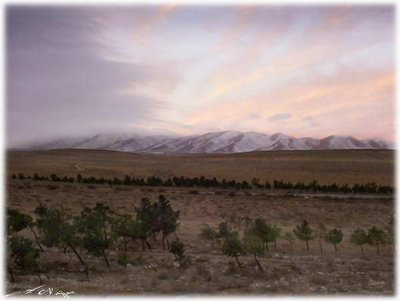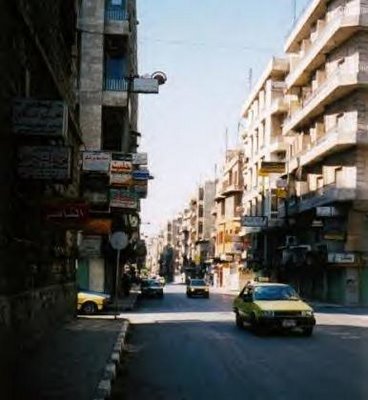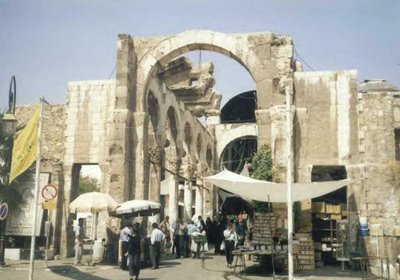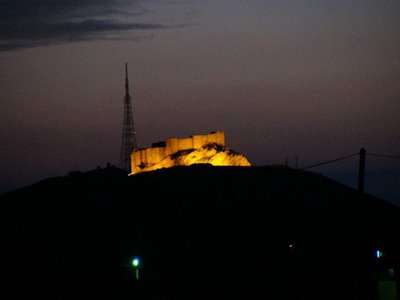
Aleppo is the oldest continuously inhabited city in history along with Damascus. Experience the city and more from Syria right here.

Tuesday, April 18, 2006
Roman Theatre (Bosra - بصرى)
Bosra boasts one of the best preserved Roman amphitheatres of the Roman world where performances are still held today, including the internationally acclaimed annual arts festival.

Bosra - بصرى
Situated 140 Km south of Damascus in the Horan plain, is the ancient city of Bosra. This city of Bosra, was first mentioned in the Hieroglyphics of Thutmos III and Akhnatoun in the 14th century BC, and 1000 years later was the capital of the Nabatean kingdom under the name of Bousra. Later in the Hellenistic era it bore the name of Boustra.
Bosra, grew the most under the Romans, who paid great attention to it and was named Niatrojana Bostra as the capital of the state of Djezire under the king Trojan. It was later attacked by Zenobia in 268 AD, however she only occupied it for a while and did not leave her mark. In the Byzantine period Bosra became the seat of an archbishop who was in charge of 33 bishops in the area.
In 632 AD, Bosra was the first Byzantine city to fall to the Arab Muslims, and it flourished greatly as a point on both the trade route and the pilgrimage route between Damascus and Mecca. The crusaders failed to take it over but it was their threat that pushed the Ayyubids into converting the theater into a fortress. Bosra survived the Mongol invasion, and later under the Mamelukes the main pilgrimage routes moved westwards and this left Bosra quite abandoned, until the Druze moved here from Lebanon in the 18th and19th centuries.
Bosra is most famous for its magnificent Roman amphitheater, which was later converted into a fortress by the Ayyubids. The original theater, which has been miraculously preserved, seats 15 000 and its stage is 45 meters in length and 8 meters in depth. It has been designed so that all the audience can hear the actors without the use of any special equipment. The theater has been renovated and restored, especially a lot of the columns. There is a large area in front of the stage that might've been used for circuses or gladiatorial matches.
Most of the Ayyubid fortress that envelops the theater remains. It was built by the Ayyubids except for a few towers built by the Seljuks. One of the Ayyubid towers on the outer arc has now been turned into a folkloric museum.
The rest of Bosra is a city resembling the nearby town of Shahba, and like most other Roman cities is built in a grid like pattern. Other vestiges include a monumental arch, the western gate called Bab Al Hawa, the Roman baths, the Mosque of Omar (one of the oldest surviving mosques), the Cathedral of Bosra, the Mameluke baths Hamam Manjak, a Nabatean arch and the basilica known as Church of Bahira. Bahira was a Nestorian Christian monk who met the Prophet Muhammad صلى الله عليه وسلم when Muhammad صلى الله عليه وسلم was 12 years of age, and noticed the seal of prophecy and claimed that he would have a great future.
Also found in the city of Bosra, are the Mosques of Fatima and Mabrak (Mabrak, is where it is said that Muhammad's camel knelt at the spot of the Mihrab). There is an enormous cistern which, at 120 meters by 150 meters is one of the largest the Romans ever built
Bosra, grew the most under the Romans, who paid great attention to it and was named Niatrojana Bostra as the capital of the state of Djezire under the king Trojan. It was later attacked by Zenobia in 268 AD, however she only occupied it for a while and did not leave her mark. In the Byzantine period Bosra became the seat of an archbishop who was in charge of 33 bishops in the area.
In 632 AD, Bosra was the first Byzantine city to fall to the Arab Muslims, and it flourished greatly as a point on both the trade route and the pilgrimage route between Damascus and Mecca. The crusaders failed to take it over but it was their threat that pushed the Ayyubids into converting the theater into a fortress. Bosra survived the Mongol invasion, and later under the Mamelukes the main pilgrimage routes moved westwards and this left Bosra quite abandoned, until the Druze moved here from Lebanon in the 18th and19th centuries.
Bosra is most famous for its magnificent Roman amphitheater, which was later converted into a fortress by the Ayyubids. The original theater, which has been miraculously preserved, seats 15 000 and its stage is 45 meters in length and 8 meters in depth. It has been designed so that all the audience can hear the actors without the use of any special equipment. The theater has been renovated and restored, especially a lot of the columns. There is a large area in front of the stage that might've been used for circuses or gladiatorial matches.
Most of the Ayyubid fortress that envelops the theater remains. It was built by the Ayyubids except for a few towers built by the Seljuks. One of the Ayyubid towers on the outer arc has now been turned into a folkloric museum.
The rest of Bosra is a city resembling the nearby town of Shahba, and like most other Roman cities is built in a grid like pattern. Other vestiges include a monumental arch, the western gate called Bab Al Hawa, the Roman baths, the Mosque of Omar (one of the oldest surviving mosques), the Cathedral of Bosra, the Mameluke baths Hamam Manjak, a Nabatean arch and the basilica known as Church of Bahira. Bahira was a Nestorian Christian monk who met the Prophet Muhammad صلى الله عليه وسلم when Muhammad صلى الله عليه وسلم was 12 years of age, and noticed the seal of prophecy and claimed that he would have a great future.
Also found in the city of Bosra, are the Mosques of Fatima and Mabrak (Mabrak, is where it is said that Muhammad's camel knelt at the spot of the Mihrab). There is an enormous cistern which, at 120 meters by 150 meters is one of the largest the Romans ever built
Monday, April 17, 2006
The Azem Palace (Hama - حماه)
Traditional Arabian Housing (example in Hama - حماه)
This is an example of traditional Arabic housing. This house is in Hama.
As these are some of the oldest housing they lack planning and therefore suffer some problems such as condensation which is why they have been redone. It is illegal to knock them down and rebuild so only renovation is allowed. They are upon the most expensive housing in Arabia and as you can see they are usually a large open space in the middle with plants, fountains and a seating area, and rooms all around.

As these are some of the oldest housing they lack planning and therefore suffer some problems such as condensation which is why they have been redone. It is illegal to knock them down and rebuild so only renovation is allowed. They are upon the most expensive housing in Arabia and as you can see they are usually a large open space in the middle with plants, fountains and a seating area, and rooms all around.
Traditional Arabian Housing (example in Damascus)
This is an example of traditional Arabic housing. This house is in Damascus and has been redone.
As these are some of the oldest housing they lack planning and therefore suffer some problems such as condensation which is why they have been redone. It is illegal to knock them down and rebuild so only renovation is allowed. They are upon the most expensive housing in Arabia and as you can see they are usually a large open space in the middle with plants, fountains and a seating area, and rooms all around. Upstairs there are balconies as you can see.

As these are some of the oldest housing they lack planning and therefore suffer some problems such as condensation which is why they have been redone. It is illegal to knock them down and rebuild so only renovation is allowed. They are upon the most expensive housing in Arabia and as you can see they are usually a large open space in the middle with plants, fountains and a seating area, and rooms all around. Upstairs there are balconies as you can see.
Sunday, April 16, 2006
Saturday, April 15, 2006
Teshreen Road (Aleppo - حلب)
Al Jamilieh (Aleppo - حلب)
Sunday, April 09, 2006
Palmyra - تدمر
Palmyra (Tadmor in Arabic) is in the heart of Syrian Desert, and is often described as the bride of the desert.
Its magnificent remains tell of a heroic history during the reign of Queen Zenobia.
The Oasis, as it is sometimes called, is located near a hot-water spring called Afqa, which make it an ideal halt for caravans moving between Iraq and Al-Sham (present day Syria, Lebanon, Holy Land and Jordan), trading in silk from China to the Mediterranean. This strategic location made Palmyra prosper in a well-established kingdom from the 2nd century BC.
After Romans conquered Syria, Palmyra flourished and became known as city of palm-trees. When Emperor Adrian visited Palmyra, he declared it a free city; in return, people of Palmyra gratefully called their city Adrianapalmyra.
The Severus emperors then, who were originally Syrian, came to rule Palmyra, they treated its people extremely well. Emperor Caracalla declared it a Roman colony, which made it a luxurious one: new constructions, streets, arches, temples and statues were built, making Palmyra one of the greatest cities of Roman empire.
When conflict between Persia and Rome reached its crisis, Rome resorted to ruler of Palmyra for help. This ruler, Auzaina, managed to withstand Persian armies, which led Romans to call him leader of East. But he was soon assassinated in mysterious circumstances, and his second wife, Queen Zenobia, a woman renowned for her exceptionally strong character, took power.
Zenobia ruled Palmyra in a way that astonished both West and East. She was exceptionally intelligent and attractive. She was a gifted linguist, an eloquent speaker of Palmyrian, Greek and Egyptian. Zenobia had a wide knowledge of politics, and in her court, she had many philosophers, scholars and theologians.
Queen Zenobia was soon fired by ambition of getting rid of Roman domination. In 268, during reign of Emperor Aurelian, she decided to conquer all of Rome's territories. He was then very much engaged in internal conflicts as well as external wars. This enabled her to take over whole Syria, conquer Egypt and send armies to Asia Minor, gaining control thereby of all land and sea ways to Far East. She took the title of August, which was only used by emperor of Rome, and she had money coined with her and her son's likeness upon it, without that of Rome emperor.
However, Emperor Aurelian took quick action in settling his internal disputes, and started to plan his revenge on Queen Zenobia. He formed a new army for this purpose, which proceeded through Turkey to conquer Zenobia's army in their first defensive position in Homs. It besieged Palmyra until it fell in 274. Queen Zenobia was defeated and taken captive to Rome, fettered in chains of gold where she poisoned herself.
The destiny of the great kingdom of Palmyra was no better than that of its queen; the city fell prey to looting and destruction. Archaeologists are still working on excavations there in order to uncover queen's palace, which was destroyed by Romans and replaced by a military camp.
Queen Zenobia's ambitious dream is still embodied in the magnificent remains of what she built. Palmyra ruins, which covers an area of 6 square kilometers, requires a full day in order to form an adequate idea of the beauty of the remaining architecture such as Baal-Shamin Temple, Bel Temple, Arch of Triumph, the Amphitheater, the Baths, the Straight Street, the Congress Council and the Cemeteries.

Its magnificent remains tell of a heroic history during the reign of Queen Zenobia.
The Oasis, as it is sometimes called, is located near a hot-water spring called Afqa, which make it an ideal halt for caravans moving between Iraq and Al-Sham (present day Syria, Lebanon, Holy Land and Jordan), trading in silk from China to the Mediterranean. This strategic location made Palmyra prosper in a well-established kingdom from the 2nd century BC.
After Romans conquered Syria, Palmyra flourished and became known as city of palm-trees. When Emperor Adrian visited Palmyra, he declared it a free city; in return, people of Palmyra gratefully called their city Adrianapalmyra.
The Severus emperors then, who were originally Syrian, came to rule Palmyra, they treated its people extremely well. Emperor Caracalla declared it a Roman colony, which made it a luxurious one: new constructions, streets, arches, temples and statues were built, making Palmyra one of the greatest cities of Roman empire.
When conflict between Persia and Rome reached its crisis, Rome resorted to ruler of Palmyra for help. This ruler, Auzaina, managed to withstand Persian armies, which led Romans to call him leader of East. But he was soon assassinated in mysterious circumstances, and his second wife, Queen Zenobia, a woman renowned for her exceptionally strong character, took power.
Zenobia ruled Palmyra in a way that astonished both West and East. She was exceptionally intelligent and attractive. She was a gifted linguist, an eloquent speaker of Palmyrian, Greek and Egyptian. Zenobia had a wide knowledge of politics, and in her court, she had many philosophers, scholars and theologians.
Queen Zenobia was soon fired by ambition of getting rid of Roman domination. In 268, during reign of Emperor Aurelian, she decided to conquer all of Rome's territories. He was then very much engaged in internal conflicts as well as external wars. This enabled her to take over whole Syria, conquer Egypt and send armies to Asia Minor, gaining control thereby of all land and sea ways to Far East. She took the title of August, which was only used by emperor of Rome, and she had money coined with her and her son's likeness upon it, without that of Rome emperor.
However, Emperor Aurelian took quick action in settling his internal disputes, and started to plan his revenge on Queen Zenobia. He formed a new army for this purpose, which proceeded through Turkey to conquer Zenobia's army in their first defensive position in Homs. It besieged Palmyra until it fell in 274. Queen Zenobia was defeated and taken captive to Rome, fettered in chains of gold where she poisoned herself.
The destiny of the great kingdom of Palmyra was no better than that of its queen; the city fell prey to looting and destruction. Archaeologists are still working on excavations there in order to uncover queen's palace, which was destroyed by Romans and replaced by a military camp.
Queen Zenobia's ambitious dream is still embodied in the magnificent remains of what she built. Palmyra ruins, which covers an area of 6 square kilometers, requires a full day in order to form an adequate idea of the beauty of the remaining architecture such as Baal-Shamin Temple, Bel Temple, Arch of Triumph, the Amphitheater, the Baths, the Straight Street, the Congress Council and the Cemeteries.

Subscribe to:
Comments (Atom)







